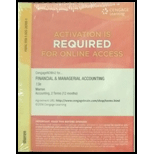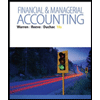
1.
Bonds Payable: Bonds payable are referred to long-term debts of the business, issued to various lenders known as bondholders, generally in multiples of $1,000 per bond, to raise fund for financing the operations.
Discount on bonds payable: It occurs when the bonds are issued at a low price than the face value.
Installment note: It is a debt in which the borrower is required to pay equal periodic payments to the lender based on the term of the note.
To Journalize: The entries to record the transactions.
1.
Explanation of Solution
| Date | Accounts and Explanation | Post Ref. | Debit ($) |
Credit ($) |
| 2016 | Cash | 63,532,267 | ||
| July 1 | Discount on Bonds Payable (1) | 10,467,733 | ||
| Bonds Payable | 74,000,000 | |||
| (To record issue of bonds at discount) | ||||
| October 1 | Cash | 200,000 | ||
| Notes Payable | 200,000 | |||
| (To record issue of 6% notes for cash) | ||||
| December 31 | Interest Expense | 3,000 | ||
| Interest Payable | 3,000 | |||
| (To record interest accrued on installment note) | ||||
| December 31 | Interest Expense (4) | 4,331,693 | ||
| Discount on Bonds Payable (2) | 261,693 | |||
| Cash (3) | 4,070,000 | |||
| (To record semiannual interest payment and amortization on bonds) |
Table (1)
| Date | Accounts and Explanation | Post Ref. | Debit ($) |
Credit ($) |
| 2017 | Interest Expense (4) | 4,331,693 | ||
| June 30 | Discount on Bonds Payable (2) | 261,693 | ||
| Cash (3) | 4,070,000 | |||
| (To record semiannual interest payment and amortization on bonds) | ||||
| September 30 | Interest Expense | 9,000 | ||
| Interest Payable | 3,000 | |||
| Notes Payable | 28,673 | |||
| Cash | 40,673 | |||
| (To record the annual payment on note) | ||||
| December 31 | Interest Expense | 2,570 | ||
| Interest Payable | 2,570 | |||
| To record interest accrued on installment note) | ||||
| December 31 | Interest Expense (4) | 4,331,693 | ||
| Discount on Bonds Payable (2) | 261,693 | |||
| Cash (3) | 4,070,000 | |||
| (To record semiannual interest payment and amortization on bonds) |
Table (2)
| Date | Accounts and Explanation | Post Ref. | Debit ($) |
Credit ($) |
| 2018 | Bonds Payable | 74,000,000 | ||
| June 30 | Loss on Redemption of Bonds (6) | 7,940,961 | ||
| Discount on Bonds Payable | 9,420,961 | |||
| Cash (5) | 72,520,000 | |||
| (To record redemption of bonds) | ||||
| September 30 | Interest Expense | 7,710 | ||
| Interest Payable | 2,570 | |||
| Notes Payable | 30,393 | |||
| Cash | 40,673 | |||
| (To record the annual payment on note) |
Table (3)
Working notes:
Calculate discount on bonds payable.
Calculate discount on bonds payable semiannually.
Calculate the amount of cash interest.
Calculate the interest expense on the bond.
Calculate cash paid to redeem the bonds.
Compute loss on the redemption of the bonds payable.
2016:
- On July 1, Cash is debited as it increased the asset. Discount on bonds payable is debited as it decreased the liability. Bonds payable is credited as it increased the liability.
- On October 1, Cash is debited as it increased the asset. Notes payable is credited as it increased the liability.
- On December 31, interest expense is debited as it decreases the equity value. Interest payable is credited as it increased the liability.
- On December 31, interest expense is debited as it decreases the equity value. Discount on bonds payable is credited as it increased the liability. Cash is credited as it decreased the asset.
2017:
- On June 30, interest expense is debited as it decreases the equity value. Discount on bonds payable is credited as it increased the liability. Cash is credited as it decreased the asset.
- On September 30, interest expense is debited as it decreases the equity value. Interest payable and notes payable are debited as it decreased the liability. Cash is credited as it decreased the asset.
- On December 31, interest expense is debited as it decreases the equity value. Interest payable is credited as it increased the liability.
- On December 31, interest expense is debited as it decreases the equity value. Discount on bonds payable is credited as it increased the liability. Cash is credited as it decreased the asset.
2018:
- On June 30, Bonds payable is debited as it decreased liability. Loss on redemption of bonds is debited as it decreases the equity value. Discount on bonds payable is credited as it increased the liability. Cash is credited as it decreased the asset.
- On September 30, interest expense is debited as it decreases the equity value. Interest payable and notes payable are debited as it decreased the liability. Cash is credited as it decreased the asset.
2.
a.
The amount of interest expense in 2016.
2.
a.
Explanation of Solution
Determine the amount of interest expense in 2016.
b.
The amount of interest expense in 2017.
b.
Explanation of Solution
Determine the amount of interest expense in 2017.
3.
The carrying amount of bonds as of December 31, 2017.
3.
Explanation of Solution
Determine the carrying amount of bonds as of December 31, 2017.
| Particulars | Amount ($) |
| Initial carrying amount of bonds | 63,532,267 |
| Discount amortized on December 31, 2016 | 261,693 |
| Discount amortized on June 30, 2017 | 261,693 |
| Discount amortized on December 31, 2017 | 261,693 |
| Carrying amount of bonds, December 31, 2017 | 64,317,346 |
Table (4)
Want to see more full solutions like this?
Chapter 12 Solutions
CengageNOWv2, 2 terms Printed Access Card for Warren?s Financial & Managerial Accounting, 13th, 13th Edition
- Question 1arrow_forwardHorngren's Financial & Managerial Accounting: The Managerial Chapters, 8th Edition. Lily-Mae makes handheld calculators in two models: basic and professional. Lily-Mae estimated $812,500 of manufacturing overhead and 625,000 machine hours for the year. The basic model actually consumed 250,000 machine hours, and the professional model consumed 375,000 machine hours.Compute the predetermined overhead allocation rate using machine hours (MHr) as the allocation base. How much overhead is allocated to the basic model? To the professional model? Basic $325,000arrow_forward3. A corporation's working capital is calculated using which amounts? Total Assets And Total Liabilities Total Assets And Current Liabilities Current Assets And Current Liabilitiesarrow_forward
- The changes that occurred during a recent year in the accounts Retained Earnings and Treasury Stock will be presented in which financial statement? Balance Sheet Income Statement Statement Of Cash Flows Statement Of Comprehensive Income Statement Of Stockholders' Equityarrow_forwardThe amount spent for capital expenditures will be reported in which section of the statement of cash flows? Cash Provided/used In Financing Activities Cash Provided/used In Investing Activities Cash Provided/used In Operating Activities Supplemental Informationarrow_forwardWhich of the following will appear as a negative amount on a statement of cash flows that was prepared using the indirect method? A Decrease In Inventory An Increase In Accounts Payable An Increase In Accounts Receivable Depreciation Expensearrow_forward
 Financial AccountingAccountingISBN:9781305088436Author:Carl Warren, Jim Reeve, Jonathan DuchacPublisher:Cengage Learning
Financial AccountingAccountingISBN:9781305088436Author:Carl Warren, Jim Reeve, Jonathan DuchacPublisher:Cengage Learning Financial Accounting: The Impact on Decision Make...AccountingISBN:9781305654174Author:Gary A. Porter, Curtis L. NortonPublisher:Cengage LearningPrinciples of Accounting Volume 1AccountingISBN:9781947172685Author:OpenStaxPublisher:OpenStax College
Financial Accounting: The Impact on Decision Make...AccountingISBN:9781305654174Author:Gary A. Porter, Curtis L. NortonPublisher:Cengage LearningPrinciples of Accounting Volume 1AccountingISBN:9781947172685Author:OpenStaxPublisher:OpenStax College Financial & Managerial AccountingAccountingISBN:9781285866307Author:Carl Warren, James M. Reeve, Jonathan DuchacPublisher:Cengage Learning
Financial & Managerial AccountingAccountingISBN:9781285866307Author:Carl Warren, James M. Reeve, Jonathan DuchacPublisher:Cengage Learning Cornerstones of Financial AccountingAccountingISBN:9781337690881Author:Jay Rich, Jeff JonesPublisher:Cengage Learning
Cornerstones of Financial AccountingAccountingISBN:9781337690881Author:Jay Rich, Jeff JonesPublisher:Cengage Learning College Accounting, Chapters 1-27AccountingISBN:9781337794756Author:HEINTZ, James A.Publisher:Cengage Learning,
College Accounting, Chapters 1-27AccountingISBN:9781337794756Author:HEINTZ, James A.Publisher:Cengage Learning,





